The
Phonograph and Its Future
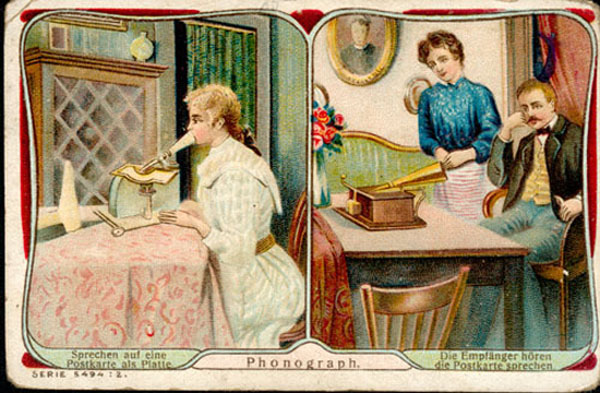
Probability:
Letter Writing
.
Letter Writing.--
The apparatus now being perfected in mechanical details will be
the standard phonograph, and may be used for all purposes, except
such as require special form of matrix, such as toys, clocks, etc.,
for an indefinite repetition of the same thing. The main utility of
the phonograph, however, being for the purpose of letter-writing and
other forms of dictation, the design is made with a view to its utility
for that purpose.
The "Letter Writing" probability
overlaps with Edison's Dictation
since in the early years Edison recognized that people on the other
end receiving a recorded letter might not have an "apparatus"
that would allow them to listen. Therefore, notes Edison, this would
necessitate a written letter of the old-fashioned sort but for which
a phonograph as a dicatation machine could still be used.
The following examples focus on the
letter being the recorded message for this 'probability' of letter
writing rather than dictation and transfer to paper.
In November 1892, President elect Cleveland
received a congratulatory letter on a phonograph record from "an
admirer." The phonograph trade magazine The Phonogram
showed an illustration "Listening to the Message" and provided
the text of the 'letter.'
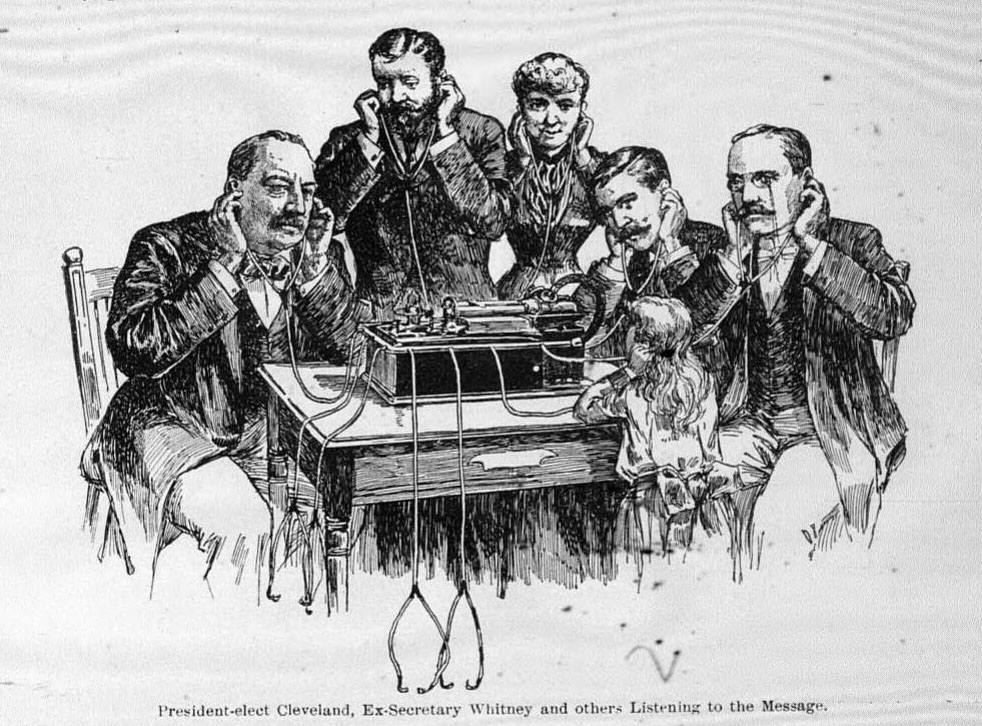
The Phonogram,
November 1892
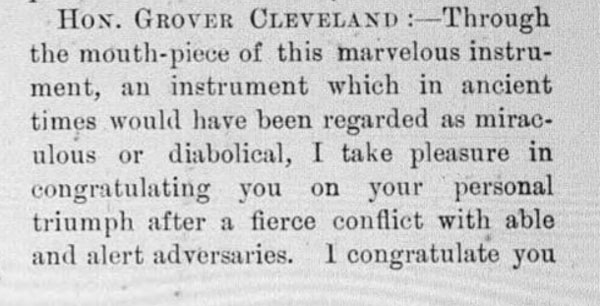

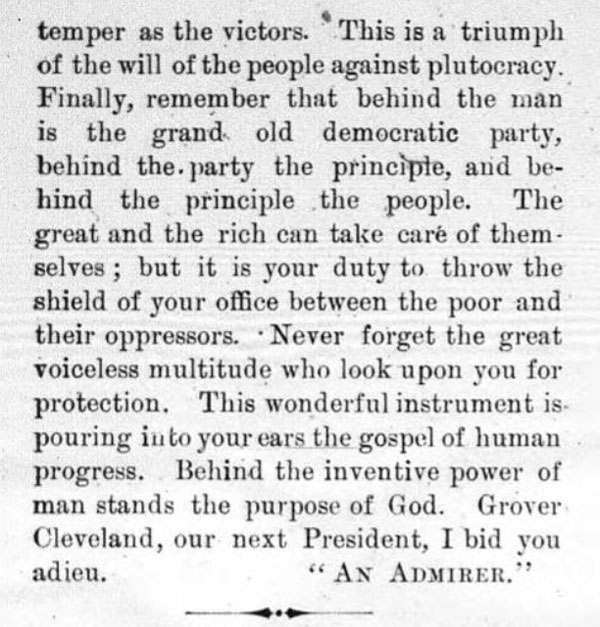
Early cylinder machines like Edison's
Phonograph and Columbia's Graphophone in the last half of the 1890's
were designed and marketed for the home and they had the functionality
to record and reproduce "your own voice."

1896
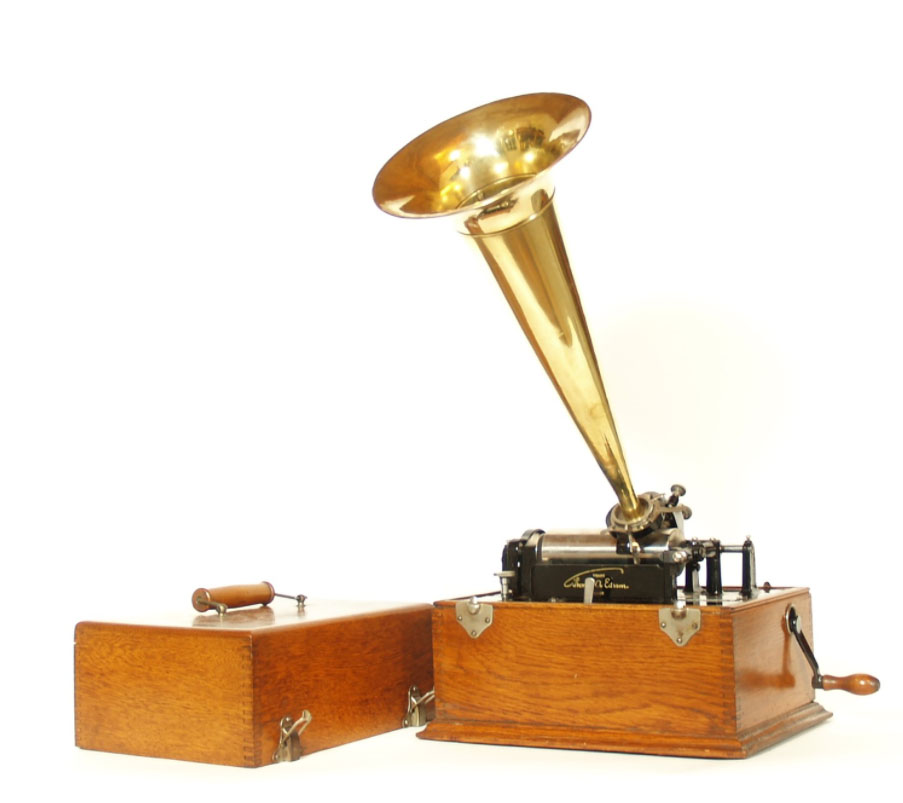
1899 Edison Standard
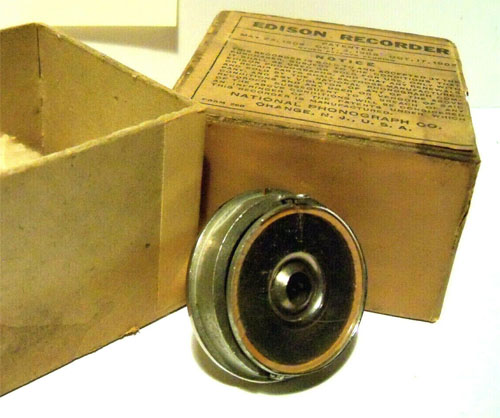
Edison Recorder Stylus
.
Because these early cylinder phonographs
used wax cylinders, however, mailing them as a 'substitute' letter
had risks. Most recorded voices on wax cylinders probably never left
the home but could become part of a family album, i.e., an acoustic
album and literally 'records' of family voices and "audio portraits"
in parallel with the family photo album. Edison, in fact, predicted
that the phonograph would " unquestionably outrank the photograph."
(See Edison's Family Record
probability for more details.)
The Edison Historic Site, however, does
have an example of a 'phonograph letter' on a cylinder record from
President Diaz of Mexico to Edison thanking him via a cylinder record
for the letter Edison sent him.
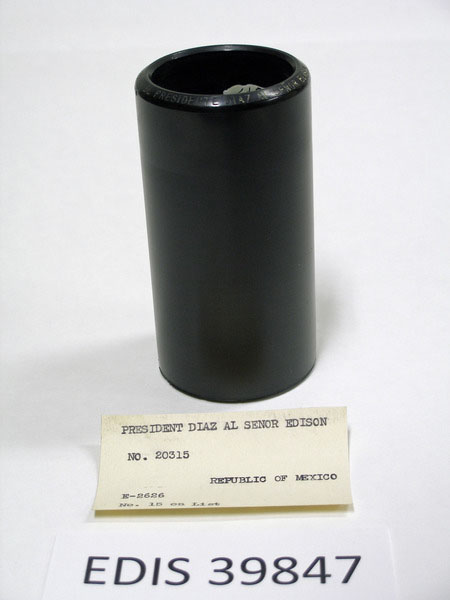
LISTEN
Courtesy of the Thomas Edison National
Historical Park, National Park Service, United States Department of
the Interior and phono-post.org
In the January 1892 edition of The
Phonogram it was noted that "ultimately a phonograph station
will be found in every post-office just as a telegraph station now
exists. From these points messages will be sent, at the price of a
few cents, to the nethermost parts of the world."
A device designed for this very purpose
was made in France and named "The Phonopostal." It is the
earliest letter writing acoustic machine that I know of for
the specific purpose of recording messages on specially prepared postcards
that could mailed.
A reproducer was supplied so that a
message could be created and sent, or for listening to one of the
special postcards (carte sonorine) received from a friend.
"Machines could be purchased by consumers, or could be used in
a store where postcards were sold." (See Antique Phonograph
Accessories & Contraptions by Fabrizio and Paul, Schiffer
Publishing 2003, 3-115.)
.
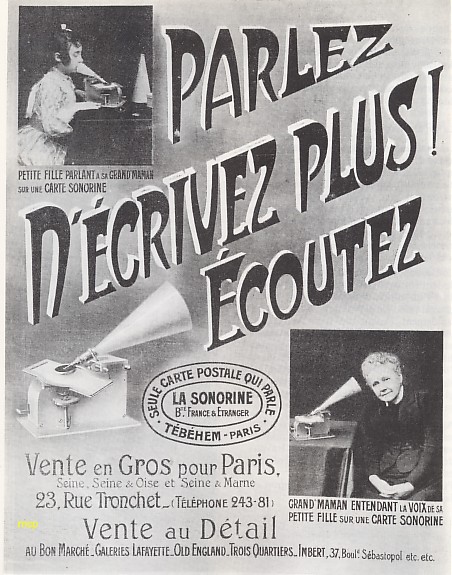
Promotional piece for La
Sonorine (recordable postcards) Courtesy of Le
Musée de la Carte Postale
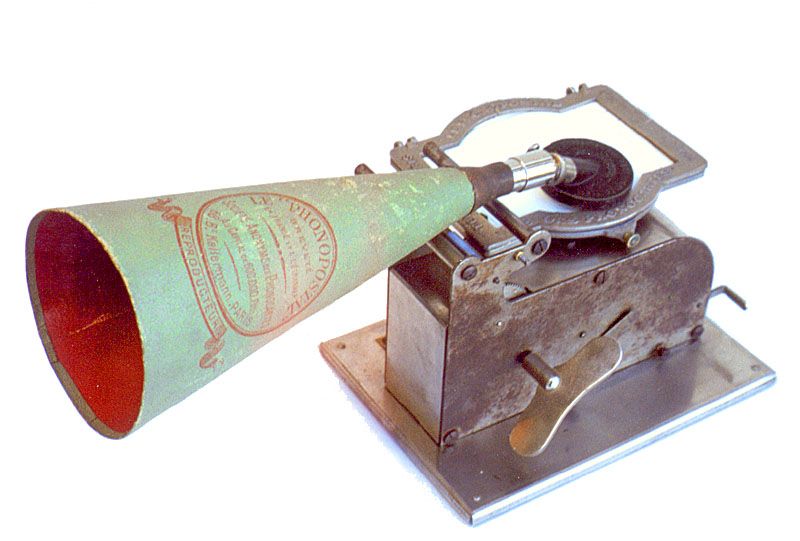
.
.
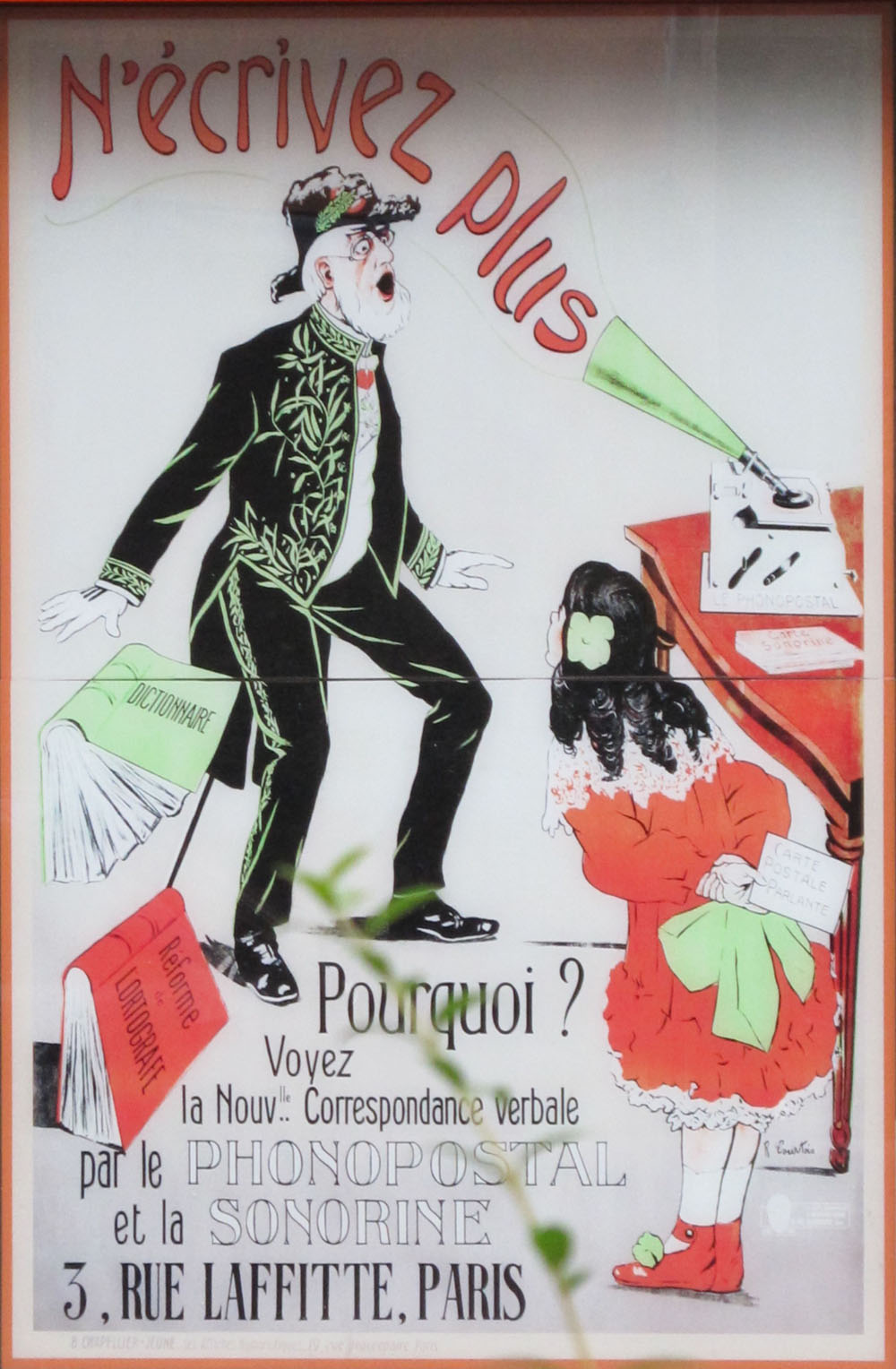
Le Phonopostal et la Sonorine
poster, 1905–1910 by Raphaël Courtois, courtesy of the
PhonoMuseum Paris
In this poster and the following ad
the girl has presumably made a recording on one of the postcards and
her father is startled as he hears it ask "Write more, why? since
this phonopostal machine with its postcards is now available and can
provide verbal correspondence --thereby no longer requiring rules
for spelling and a dictionary (which the father drops to the floor).
"Speak! No longer write! Listen!"
- The new world of correspondence made possible by "Le Phonopostal"
and its "La Sonorine" cards.
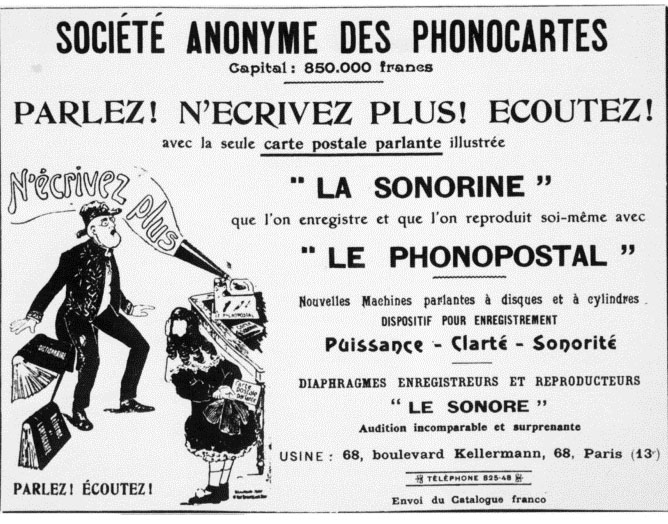
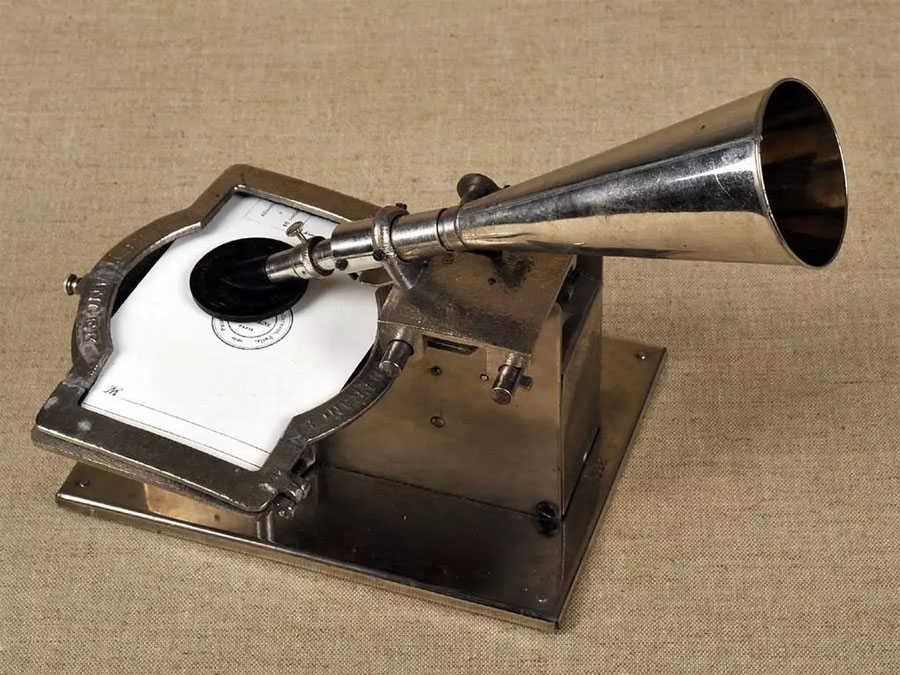
Courtesy of the Le
Musée de la Carte Postale
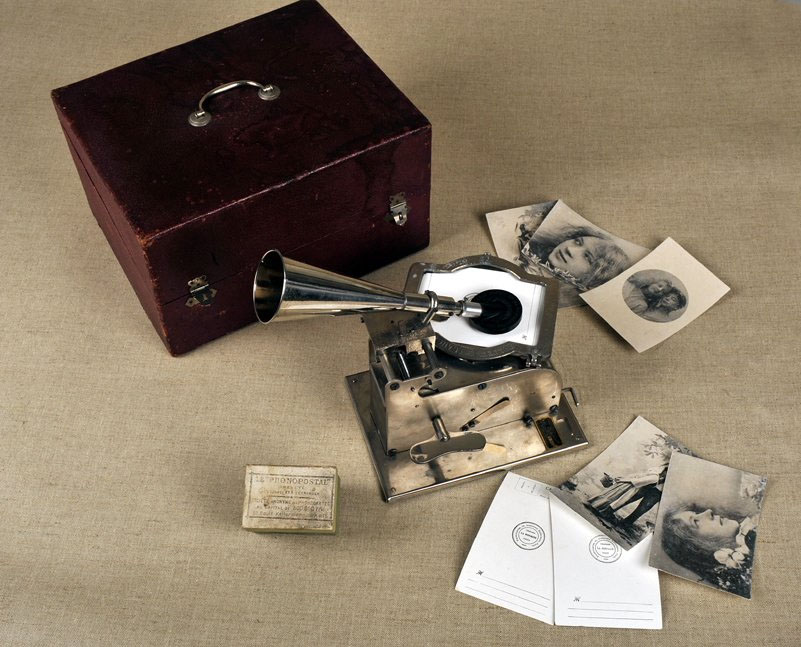
Courtesy of the Le
Musée de la Carte Postale

Courtesy of phono-post.org
Le Phonopostal and La Sonorine
cards were never introduced in America and these early examples of
'voice mail' are quite rare. It wasn't really until the 1930's that
sending records through the mail started to become truly popular.
Tom Levin has created the Phono Post
Archive at Princeton University which is the world’s first collection
of audio letters from around the globe. For more information about
this excellent collection (and especially if you have one of these
audio letters in your possession and wish to donate it) visit the
Phono-post.org.
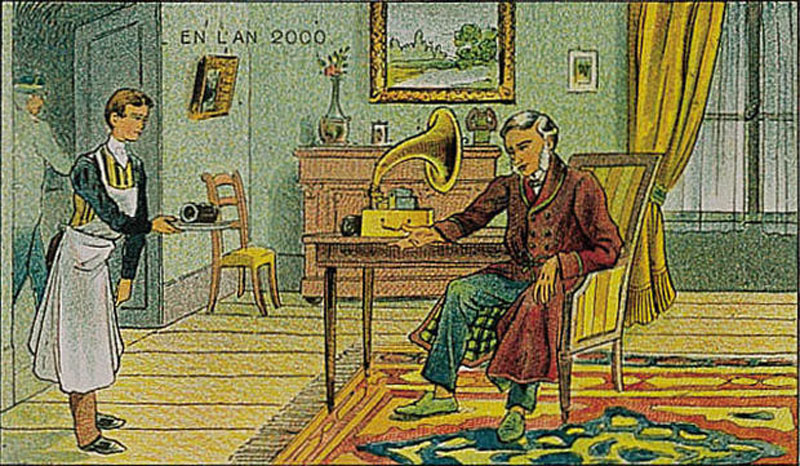
1910 postcard by Villemard predicting
how a phonogram letter will be delivered by the postman and listened
to on a phonograph in the year 2000.
For a podcast and more information about
voice mail records from the 1930's through the 1950's visit Radio
Topia's page on Voice Mail Valentines hosted by Radio
Diaries.
Here's how Radio Diaries
describes these audio letters on their
Voice Mail Valentine page:
These audio letters are small,
lightweight records made in recording booths scattered all across
the world in the 1930s, 40s and 50s. At the height of the craze,
there were booths at amusement parks, fairgrounds, military bases,
bus stops and post offices. People would enter a booth, drop a quarter
into a slot, and talk into a microphone for a minute or so.
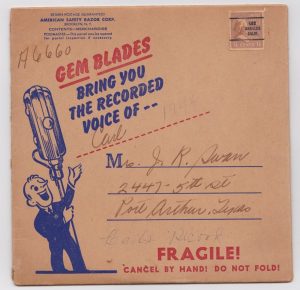
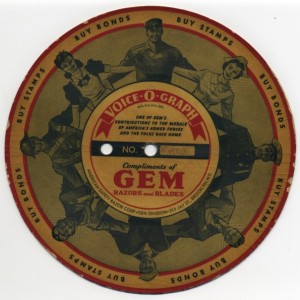
Courtesy of Radio Diaries - Support
for Radio Diaries comes from the National Endowment for the Humanities,
the National Endowment for the Arts, NYSCA, Radiotopia, and its
listeners.
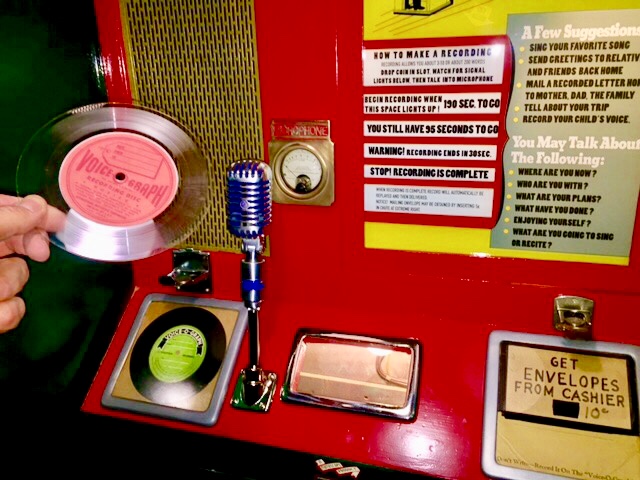
Visit the PHONOPOST
website for more information about phono booths like this one.
Phono-Post.org is a research archive investigating the media archaeology
of voicemail.
.
During World War I there were postcards
with soldiers listening to a phonograph and these could be sent as
a reminder that they were thinking of their loved ones. These postcards,
however, didn't have recordings of a soldier's voice and normally
lyrics from songs were on the front of the postcard to express the
soldier's feelings (in addition to any written message they may have
added to the postcard).
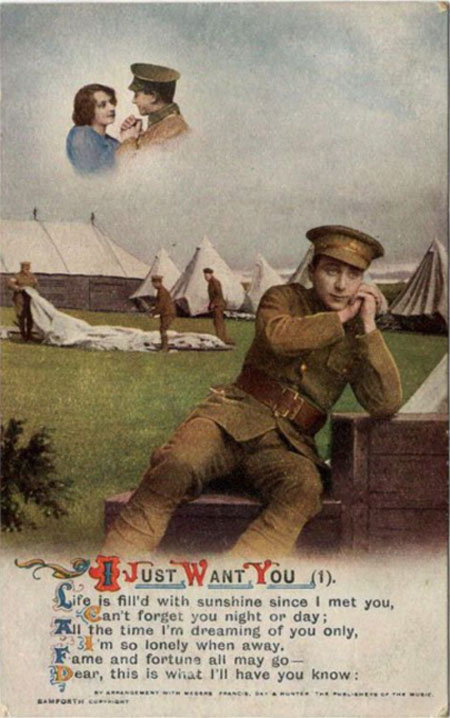
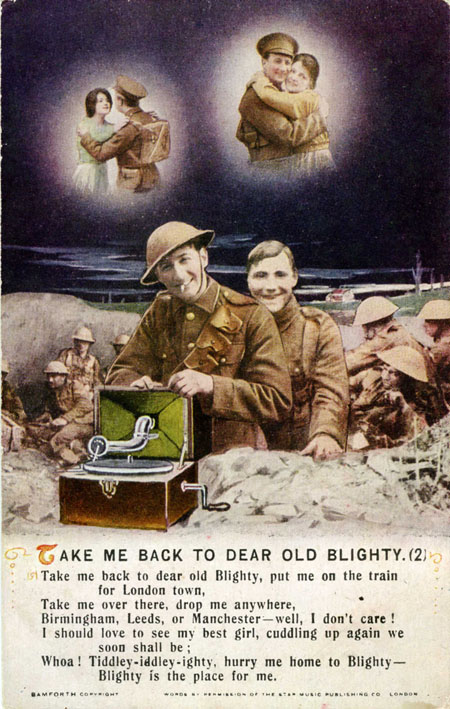
Another phonograph related postcard
made by in the 1920's and 30's had a small record attached to the
postcard, usually located over some image. These records could be
played on a 78 rpm phonograph. There were no voices on these records,
with the only message being whatever could be written on the back
of the postcard.
Tuck's Gramophone Record Post Cards
from UK postcard publisher Raphael and Sons, circa 1930
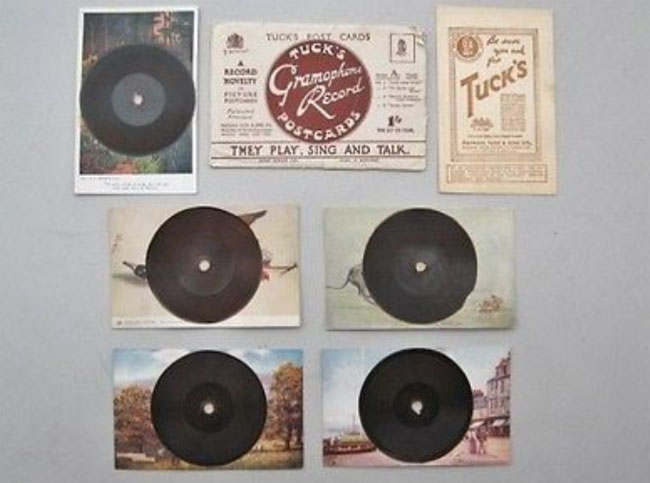
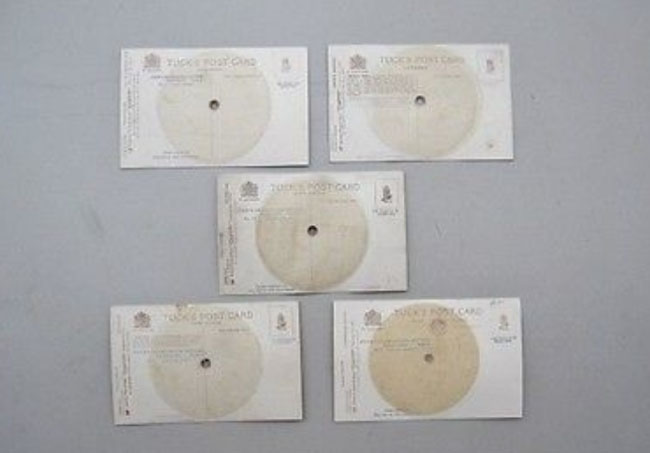
Tuck's Gramophone Post
Cards - "They Play, Sing and Talk" - 3" 78 rpm shellac
records
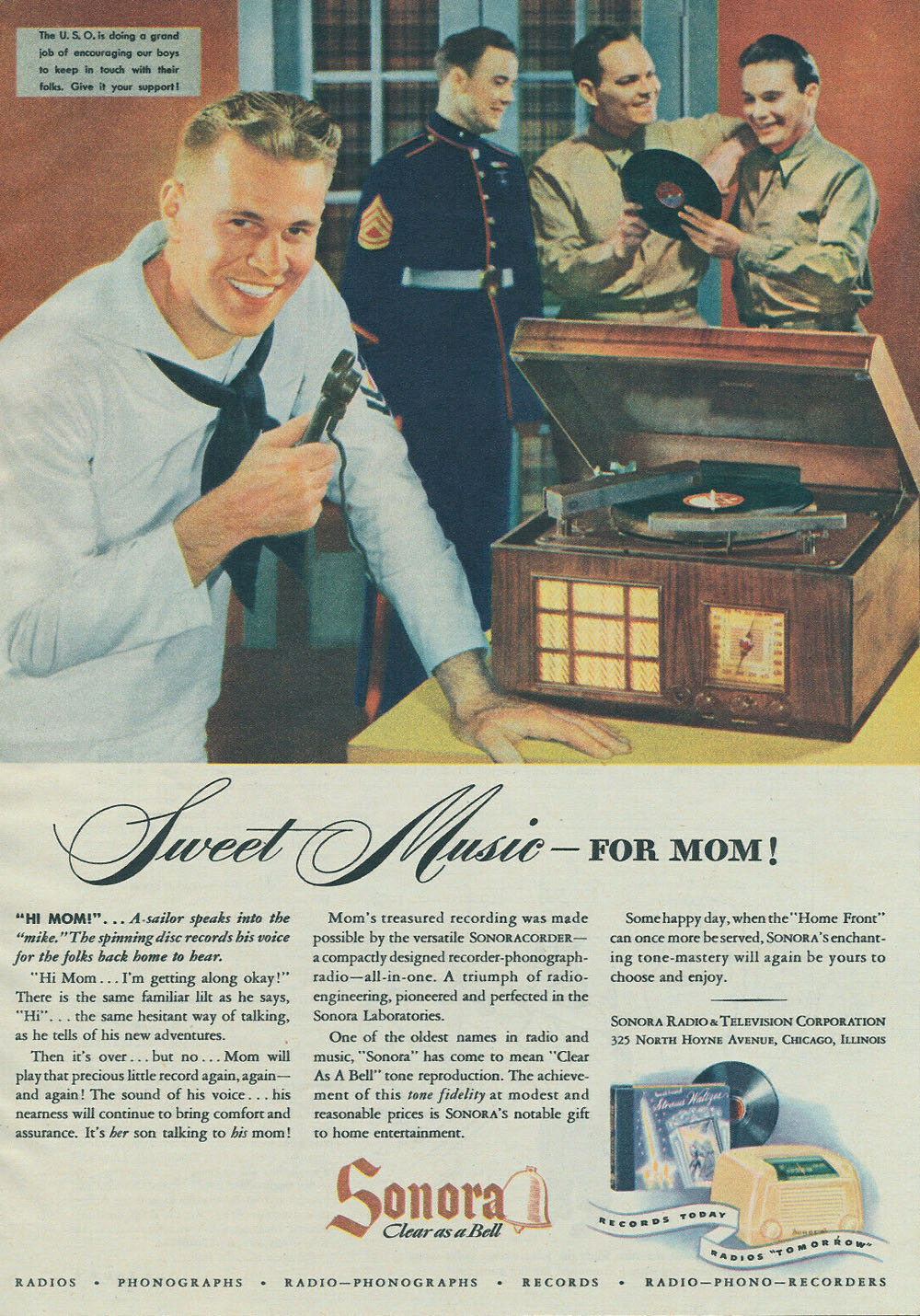
1943 Sonora Letter to Mom
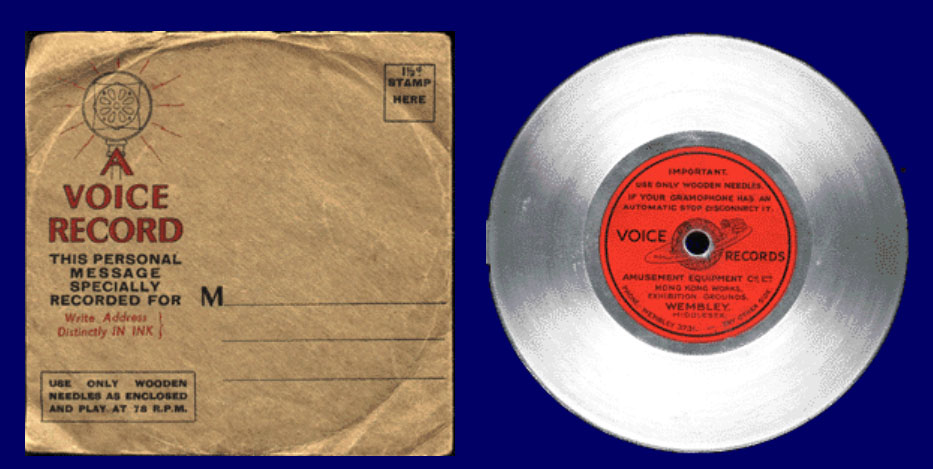
A Voice Record's postal
envelope for a Voice Record Aluminuim disc with Voice Records label
The following information about Voice
Records is courtesy of Poppyrecords.
" Voice Records' are thin
aluminium discs about the same size as a CD. They are recorded on
both sides, one side being a personal message and the other side
being a pre-recorded advertisment. They were made in the 1930s by
automatic machines installed in department stores, seaside pleasure
piers and other locations where the public might want to record
a short message which could be posted to their loved ones at home.
An envelope was provided with the record and a packet containing
a small number of wooden needles which were essential for playback
on the heavy gramophones of the day. (One playing with a steel needle
could irretrievably wipe the sound off the record).
The advertisments were usually
for cigarettes, sung by the music-hall comedian, Bobbie Comber.
Less often, the advetisment is for a local shop or attraction such
as the Pier at Weston-Super-Mare or the suppliers of bed linen for
the ocean liners based in Liverpool.
Each side of the record plays for
about one minute and the recording quality varies from quite acceptable
to absolutely dire, depending on how frequently the recording machine
was serviced. The recording machines were made by Brecknell, Munro
& Rodgers of Bristol. They were withdrawn during WWII but the casings
were re-used after the war by being converted to "Speak Your Weight"
machines or "Punch Bag" machines. The company which operated the
Voice Record booths was the Amusement Equipment Co. Ltd. of Wembly."
- Poppyrecords
During World War II the United States
government implemented their V-Disc program.
"V-Disc ("V" for Victory)
was a record label that was formed in 1943 to provide records for
U.S. military personnel. Captain Robert Vincent supervised the label
from the Special Services division.[1] Many popular singers, big
bands, and orchestras recorded V-discs." Wikipedia
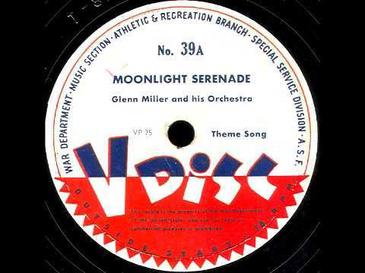
While the V-Disc program was designed
to provide music and entertainment to U.S. military personnel, other
records during WWII were made by families as "letters" to
be sent to soldiers, and likewise for soldiers to send voice letters
to their parents and loved ones. One example is Oscar Spaly's letter
to his wife made while he was at boot camp. At the time Pepsi-Cola
was working with the USO to allow soldiers to send one minute messages
to their loved ones. See mlive.com
for details about this recording.
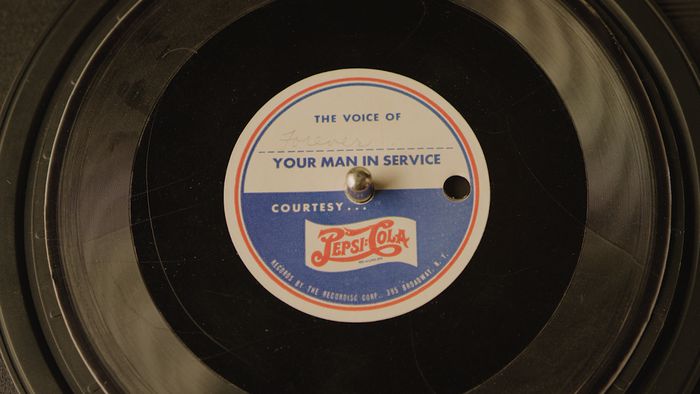
In the MLIVE article about Spaly's recording
it was explained that Pepsi "set up free recording booths
in major cities and took travel equipment to canteens across the country
for soldiers to send one-minute messages home. Many were sent before
soldiers were deployed overseas."
Dictaphones would continue to be used
into the 1960s and those dictations were being sent most often as
letters so Edison's predication of letter writing was true and also
was relatively long-lasting.
In the 20th century, of course, voice
mail came to mean messages left on telephone answering machines rather
than voices on postcards sent through the mail. Computers, smartphones,
text messages and emails would dominate interpersonal communications
until real-time social sharing websites like Facebook further replaced
the need for sending individual written letters.
As the Wall
Street Journal wrote in January 2020 with the headline "Hallmark
Cards to Revamp Operations as Greeting Cards Fade." Century-old
company plans to cut costs and refocus on digital efforts; ‘You can’t
sell a horse and buggy.’
Clearly, email and social messaging
on smartphones and video conferencing have changed the medium. And
while I don't think opening an email is like opening an envelope and
physically holding a letter but I'm not sure it really matters if
we send a digital Hallmark card or a physical Hallmark card in the
mail. I think what we are missing and what continues to disappear
is the art of writing and communicating which is more about the time
and care required from the author of that messaging. But since we
are talking about probabilities related to the introduction of recorded
sound which connects with talking movies and audio books and Zoom
and innumerable other connections, maybe Marshall McCluhan was right
and "the medium is the message."

Phonographia
|



























